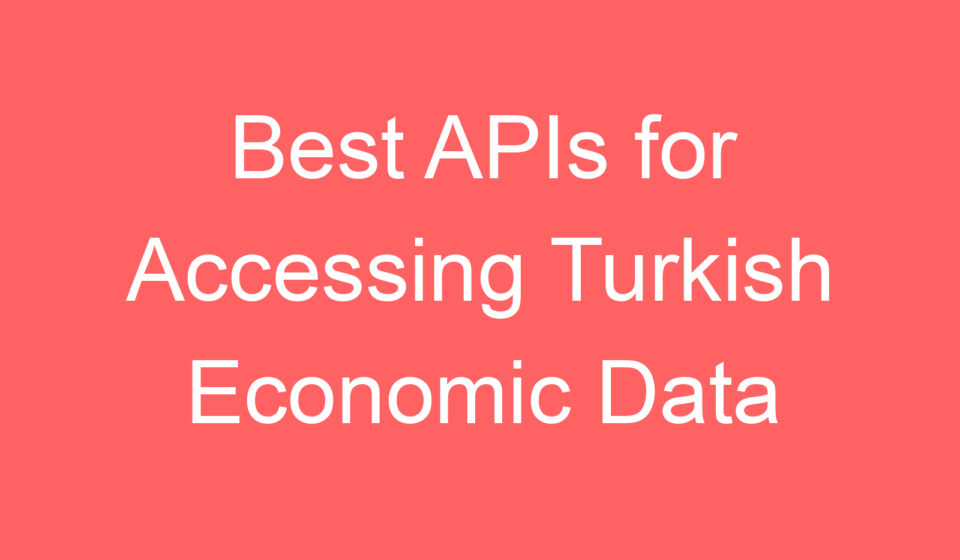
Best APIs for Accessing Turkish Economic Data
For business leaders, analysts, and researchers, having reliable access to Turkish economic and financial data is essential. Whether you are tracking inflation, monitoring exchange rates, studying labor market dynamics, or comparing Turkey’s performance to other economies, robust APIs make it possible to integrate real-time insights directly into dashboards, applications, and business intelligence tools. A strong API strategy saves time, reduces manual data entry errors, and ensures you are always working with the freshest figures available. This extended guide introduces the most important APIs for Turkish economic data, explains their strengths and weaknesses in detail, and suggests how to combine them for maximum value.
Table Of Content
- 1. TCMB EVDS (Central Bank of Turkey – Electronic Data Delivery System)
- 2. TÜİK – Turkish Statistical Institute
- 3. Trading Economics API
- 4. dxFeed (Borsa İstanbul Market Data)
- 5. NosyAPI and Other Local Providers
- Choosing the Right API
- Recommended Stack for Businesses
- Practical Integration Tips
- Final Thoughts
- Related Posts
1. TCMB EVDS (Central Bank of Turkey – Electronic Data Delivery System)
The Elektronik Veri Dağıtım Sistemi (EVDS) is the Central Bank of Turkey’s official data distribution service. It stands as the most authoritative source for monetary, banking, and macroeconomic data series in Turkey.
- 📊 Coverage: Daily FX rates, interest rates, credit volumes, banking sector balance sheets, balance of payments, inflation indicators, and monetary aggregates.
- 📂 Formats: JSON, CSV, XML, and Excel-compatible formats.
- 💰 Cost: Free, requires registration for an API key.
- ✅ Advantages: Official, reliable, comprehensive, and backed by the central bank. Supports aggregation and formula calculations directly in API calls.
- ⚠️ Considerations: Data is usually daily, monthly, or quarterly depending on the indicator. Real-time tick data is not provided. Some series may be subject to revisions and reporting delays.
👉 If your business needs authoritative Turkish central bank and financial indicators, EVDS is the essential foundation for your data stack.
Example Use Case: A fintech firm can use EVDS to automatically update daily exchange rate dashboards or integrate Turkish inflation and policy rates into credit risk models.
2. TÜİK – Turkish Statistical Institute
The Turkish Statistical Institute (TÜİK) provides official statistics across virtually every area of Turkey’s economy and society. It is the go-to source for long-term structural data and nationwide surveys.
- 📊 Coverage: GDP, employment/unemployment rates, demographic shifts, consumer prices, producer prices, import/export statistics, and household surveys.
- 📂 Formats: Open data portal, downloadable tables, and API endpoints.
- 💰 Cost: Free and publicly available.
- ✅ Advantages: Authoritative and broad coverage across economic and social fields. Provides datasets not available from the central bank, such as detailed labor and population statistics.
- ⚠️ Considerations: The interface can be challenging for beginners. Some data sets may require preprocessing to standardize formats for integration.
👉 TÜİK is ideal for businesses and researchers analyzing Turkey’s economic fundamentals, population dynamics, and trade flows.
Example Use Case: A consultancy can build long-term economic forecasts by integrating GDP growth, employment, and demographic projections from TÜİK into its analytical models.
3. Trading Economics API
For businesses seeking both Turkish and international data in a unified format, Trading Economics provides an aggregator API with extensive coverage.
- 📊 Coverage: Macro indicators, forecasts, economic calendar events, and cross-country datasets.
- 💰 Pricing: From $29/month (basic) to $399/month (professional). Higher tiers unlock more requests and advanced features.
- ✅ Advantages: Convenient global coverage, standardized formats, and inclusion of forecasts and consensus expectations alongside official historical data. Offers ready-made client libraries for Python, R, and other languages.
- ⚠️ Considerations: Some Turkish data may be slightly delayed compared to direct sources like EVDS or TÜİK. Forecasts are useful but not official, so they should be treated as guidance rather than fact.
👉 Use Trading Economics when you want Turkey’s indicators side by side with global data for benchmarking and strategy.
Example Use Case: A multinational firm monitoring Turkey, Brazil, and India can use Trading Economics to compare inflation and exchange rate data across countries with a single API integration.
4. dxFeed (Borsa İstanbul Market Data)
For businesses operating in financial markets, dxFeed delivers professional-grade securities data from Borsa İstanbul (BIST).
- 📊 Coverage: Real-time and historical market data for equities, derivatives, indices, and futures traded on BIST.
- 📂 Formats: REST, FIX API, Python and Java SDKs.
- 💰 Pricing: Negotiated, based on instruments, latency needs, and historical depth.
- ✅ Advantages: Provides intraday and tick-level data, ideal for trading platforms and investment analysis. Includes historical replay services.
- ⚠️ Considerations: Licensing and costs can be high, especially for real-time feeds. Contracts are typically required.
👉 dxFeed is the right choice if your systems require live or intraday securities data from Turkey’s main exchange.
Example Use Case: An investment firm can integrate dxFeed into its portfolio monitoring system to get second-by-second updates on BIST stocks and indices.
5. NosyAPI and Other Local Providers
Smaller Turkish providers, such as NosyAPI, offer targeted financial services with simpler access.
- 📊 Coverage: Foreign exchange rates, gold and silver prices, basic economic calendars.
- ✅ Advantages: Easy to use, quick integration for consumer apps or websites.
- ⚠️ Considerations: Narrow scope, limited historical depth, and lower reliability compared to EVDS or TÜİK. SLAs and documentation may be minimal.
👉 NosyAPI is useful for lightweight applications, mobile apps, or consumer portals displaying currency and gold prices.
Example Use Case: A tourism app can integrate NosyAPI to show tourists up-to-date exchange rates and gold prices in Turkey.
Choosing the Right API
When evaluating which API fits your needs, consider these criteria in depth:
- 📊 Coverage: Does the API provide all the data series you require, or will you need multiple sources?
- ⏱️ Update Frequency: How fresh is the data? Do you need daily updates, monthly aggregates, or intraday feeds?
- 🏛️ Authority: Is the source official (like TCMB or TÜİK) or an aggregator (like Trading Economics)?
- 🔧 Integration Ease: Are there client libraries, SDKs, or sample queries available for your preferred language?
- 💰 Cost & Licensing: Is it free, subscription-based, or enterprise-negotiated? Are there restrictions on redistribution?
Recommended Stack for Businesses
To maximize reliability and breadth, consider building a hybrid stack:
- 🏦 Primary Data Layer: TCMB EVDS for official monetary and financial statistics.
- 📈 Structural & Social Data Layer: TÜİK for socio-economic, demographic, and trade statistics.
- 🌍 Global Benchmarking Layer: Trading Economics for forecasts and international comparisons.
- 💹 Market Data Layer: dxFeed for securities and market microstructure.
- 💱 Supplementary Layer: NosyAPI or similar for lightweight, real-time FX and gold data.
By blending these sources, businesses can build a resilient pipeline that covers both Turkey-specific insights and global context. This architecture also allows for redundancy: if one API is unavailable, another can serve as a fallback.
Practical Integration Tips
- 🗄️ Caching: Cache frequent queries to reduce API calls and costs.
- 📡 Monitoring: Track latency and availability of each provider with uptime monitoring.
- 🔄 Transformation: Normalize data formats across APIs for consistency.
- 🔁 Fallback: Design your system to fall back on secondary APIs when primary sources are unavailable.
- 📜 Compliance: Always check licensing and redistribution rights before publishing API data.
Final Thoughts
Accessing Turkish economic data has never been more straightforward. Whether you are a multinational corporation evaluating investments, a local fintech building dashboards, or a researcher modeling long-term economic shifts, these APIs provide essential building blocks.
Start with EVDS and TÜİK for accuracy and official statistics, add Trading Economics for context and forecasts, and include dxFeed if your operations depend on real-time financial markets. Finally, complement with local providers like NosyAPI when you need consumer-friendly, lightweight financial data. With the right combination, you can create a robust and future-proof economic data infrastructure that helps your business make smarter decisions in Turkey and beyond.

